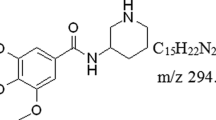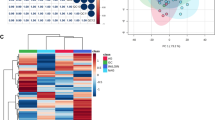Abstract
Gastric mucosal ulceration and gastric hemorrhage are frequently associated with treatment by non-steroid anti-inflammatory drugs (NSAIDs); however, no convenient biomarker-based diagnostic methods for these adverse reactions are currently available, requiring the use of endoscopic evaluation. We recently reported five biomarker candidates in serum which predict gastric injury induced by NSAIDs in rats, but were unable to clarify the mechanism of change in the levels of these biomarker candidates. In this study, we performed capillary electrophoresis–mass spectrometry-based metabolomic profiling in stomach and serum from rats in which gastric ulcer was induced by aspirin and prevented by co-administration of omeprazole and famotidine. Results showed drug-induced decreases in the levels of citrate, cis-aconitate, succinate, 3-hydroxy butanoic acid, and O-acetyl carnitine in all animals administered aspirin. In contrast, aspirin-induced decreases in the level of 4-hydroxyproline were suppressed by co-administration of omeprazole and famotidine. We consider that these changes were due to the prevention of gastric ulcer and decrease in the amount of collagen in stomach tissue by omeprazole and famotidine, without prevention of the NSAID-induced depression of mitochondrial function. In addition, the decreases in 4-hydroxyproline in the stomach was also detectable as changes in the serum. While further study is needed to clarify limitations of indications and extrapolation to humans, this new serum biomarker candidate of gastric injury may be useful in the monitoring of NSAID-induced tissue damage.




Similar content being viewed by others
References
Ban, E., Park, S. H., Kang, M. J., Lee, H. J., Song, E. J., & Yoo, Y. S. (2012). Growing trend of CE at the omics level: The frontier of systems biology—An update. Electrophoresis, 33(1), 2–13. doi:10.1002/elps.201100344.
Fiehn, O., Kopka, J., Dormann, P., Altmann, T., Trethewey, R. N., & Willmitzer, L. (2000). Metabolite profiling for plant functional genomics. Nature Biotechnology, 18(11), 1157–1161. doi:10.1038/81137.
Gabriel, S. E., & Fehring, R. A. (1992). Trends in the utilization of non-steroidal anti-inflammatory drugs in the United States, 1986–1990. Journal of Clinical Epidemiology, 45(9), 1041–1044.
Gabriel, S. E., Jaakkimainen, L., & Bombardier, C. (1991). Risk for serious gastrointestinal complications related to use of nonsteroidal anti-inflammatory drugs. A meta-analysis. Annals of Internal Medicine, 115(10), 787–796.
Hasebe, T., Harasawa, S., Miwa, T., Shibata, T., & Inayama, S. (1987). Collagen and collagenase in ulcer tissue—1. The healing process of acetic acid ulcers in rats. Tokai Journal of Experimental and Clinical Medicine, 12(3), 147–158.
Hawkey, C. J. (2000). Nonsteroidal anti-inflammatory drug gastropathy. Gastroenterology, 119(2), 521–535.
Hirayama, A., Nakashima, E., Sugimoto, M., Akiyama, S., Sato, W., Maruyama, S., et al. (2012). Metabolic profiling reveals new serum biomarkers for differentiating diabetic nephropathy. Analytical and Bioanalytical Chemistry, 404(10), 3101–3109. doi:10.1007/s00216-012-6412-x.
Katayama, H., Ishihama, Y., & Asakawa, N. (1998). Stable cationic capillary coating with successive multiple ionic polymer layers for capillary electrophoresis. Analytical Chemistry, 70(24), 5272–5277.
Lehmann, F. S., & Beglinger, C. (2005). Impact of COX-2 inhibitors in common clinical practice a gastroenterologist’s perspective. Current Topics in Medicinal Chemistry, 5(5), 449–464.
Mahmud, T., Rafi, S. S., Scott, D. L., Wrigglesworth, J. M., & Bjarnason, I. (1996). Nonsteroidal antiinflammatory drugs and uncoupling of mitochondrial oxidative phosphorylation. Arthritis and Rheumatism, 39(12), 1998–2003.
Masubuchi, Y., Yamada, S., & Horie, T. (1999). Diphenylamine as an important structure of nonsteroidal anti-inflammatory drugs to uncouple mitochondrial oxidative phosphorylation. Biochemical Pharmacology, 58(5), 861–865.
Mingatto, F. E., Santos, A. C., Uyemura, S. A., Jordani, M. C., & Curti, C. (1996). In vitro interaction of nonsteroidal anti-inflammatory drugs on oxidative phosphorylation of rat kidney mitochondria: Respiration and ATP synthesis. Archives of Biochemistry and Biophysics, 334(2), 303–308. doi:10.1006/abbi.1996.0459.
Monton, M. R., & Soga, T. (2007). Metabolome analysis by capillary electrophoresis–mass spectrometry. Journal of Chromatography A, 1168(1–2), 237–246; discussion 236. doi:10.1016/j.chroma.2007.02.065.
Moreno-Sanchez, R., Bravo, C., Vasquez, C., Ayala, G., Silveira, L. H., & Martinez-Lavin, M. (1999). Inhibition and uncoupling of oxidative phosphorylation by nonsteroidal anti-inflammatory drugs: Study in mitochondria, submitochondrial particles, cells, and whole heart. Biochemical Pharmacology, 57(7), 743–752.
Nicholson, J. K., Connelly, J., Lindon, J. C., & Holmes, E. (2002). Metabonomics: A platform for studying drug toxicity and gene function. Nature Reviews Drug Discovery, 1(2), 153–161.
Petrescu, I., & Tarba, C. (1997). Uncoupling effects of diclofenac and aspirin in the perfused liver and isolated hepatic mitochondria of rat. Biochimica et Biophysica Acta, 1318(3), 385–394.
Plumb, R., Granger, J., Stumpf, C., Wilson, I. D., Evans, J. A., & Lenz, E. M. (2003). Metabonomic analysis of mouse urine by liquid-chromatography–time of flight mass spectrometry (LC–TOFMS): Detection of strain, diurnal and gender differences. Analyst, 128(7), 819–823.
Ramautar, R., Somsen, G. W., & de Jong, G. J. (2013). CE–MS for metabolomics: Developments and applications in the period 2010–2012. Electrophoresis, 34(1), 86–98. doi:10.1002/elps.201200390.
Schauer, N., Semel, Y., Roessner, U., Gur, A., Balbo, I., Carrari, F., et al. (2006). Comprehensive metabolic profiling and phenotyping of interspecific introgression lines for tomato improvement. Nature Biotechnology, 24(4), 447–454. doi:10.1038/nbt1192.
Soga, T., Baran, R., Suematsu, M., Ueno, Y., Ikeda, S., Sakurakawa, T., et al. (2006). Differential metabolomics reveals ophthalmic acid as an oxidative stress biomarker indicating hepatic glutathione consumption. Journal of Biological Chemistry, 281(24), 16768–16776. doi:10.1074/jbc.M601876200.
Soga, T., & Heiger, D. N. (2000). Amino acid analysis by capillary electrophoresis electrospray ionization mass spectrometry. Analytical Chemistry, 72(6), 1236–1241.
Soga, T., Igarashi, K., Ito, C., Mizobuchi, K., Zimmermann, H. P., & Tomita, M. (2009). Metabolomic profiling of anionic metabolites by capillary electrophoresis mass spectrometry. Analytical Chemistry, 81(15), 6165–6174. doi:10.1021/ac900675k.
Soga, T., Sugimoto, M., Honma, M., Mori, M., Igarashi, K., Kashikura, K., et al. (2011). Serum metabolomics reveals gamma-glutamyl dipeptides as biomarkers for discrimination among different forms of liver disease. Journal of Hepatology, 55(4), 896–905. doi:10.1016/j.jhep.2011.01.031.
Somasundaram, S., Rafi, S., Hayllar, J., Sigthorsson, G., Jacob, M., Price, A. B., et al. (1997). Mitochondrial damage: A possible mechanism of the “topical” phase of NSAID induced injury to the rat intestine. Gut, 41(3), 344–353.
Steinmeyer, J. (2000). Pharmacological basis for the therapy of pain and inflammation with nonsteroidal anti-inflammatory drugs. Arthritis Research, 2(5), 379–385.
Szewczyk, A., & Wojtczak, L. (2002). Mitochondria as a pharmacological target. Pharmacological Reviews, 54(1), 101–127.
Takeda, M., Takagi, T., Yashima, Y., & Maeno, H. (1982). Effect of a new potent H2-blocker, 3-[[[2-(diaminomethylene)amino]-4-thiazolyl]methyl]thio]-N2-sulfamoyl propionamidine (YM-11170), on gastric secretion, ulcer formation and weight of male accessory sex organs in rats. Arzneimittel-Forschung, 32(7), 734–737.
Takeuchi, K., Ohishi, M., Ota, S., Suzumura, K., Naraoka, H., Ohata, T., et al. (2013). Metabolic profiling to identify potential serum biomarkers for gastric ulceration induced by nonsteroid anti-inflammatory drugs. Journal of Proteome Research, 12(3), 1399–1407. doi:10.1021/pr3010452.
Tomoda, T., Kurashige, T., Hayashi, Y., & Enzan, H. (1998). Primary changes in liver damage by aspirin in rats. Acta Paediatrica Japonica, 40(6), 593–596.
Um, S. Y., Park, J. H., Chung, M. W., Kim, K. B., Kim, S. H., Choi, K. H., et al. (2012). Nuclear magnetic resonance-based metabolomics for prediction of gastric damage induced by indomethacin in rats. Analytica Chimica Acta, 722, 87–94. doi:10.1016/j.aca.2012.01.062.
Xia, J., Broadhurst, D. I., Wilson, M., & Wishart, D. S. (2013). Translational biomarker discovery in clinical metabolomics: An introductory tutorial. Metabolomics, 9(2), 280–299. doi:10.1007/s11306-012-0482-9482.
Acknowledgments
We are grateful to Eisuke Kobayashi and Yutaka Nakahara for their technical assistance in caring for the rats, preparing samples, and estimating the dimensions of observed gastric ulcers.
Animal Studies
All institutional and national guidelines for the care and use of laboratory animals were followed.
Conflict of interest
The authors have no conflict of interest of any kind related to the work presented in this publication. This study was carried out with support from a Grant from the Ministry of Health, Labour and Welfare, Drug Discovery Platform Research (H20-bio-ippan-011).
Author information
Authors and Affiliations
Corresponding author
Electronic supplementary material
Below is the link to the electronic supplementary material.
Rights and permissions
About this article
Cite this article
Takeuchi, K., Ohishi, M., Endo, K. et al. Metabolomic analysis of the effects of omeprazole and famotidine on aspirin-induced gastric injury. Metabolomics 10, 995–1004 (2014). https://doi.org/10.1007/s11306-014-0627-0
Received:
Accepted:
Published:
Issue Date:
DOI: https://doi.org/10.1007/s11306-014-0627-0




